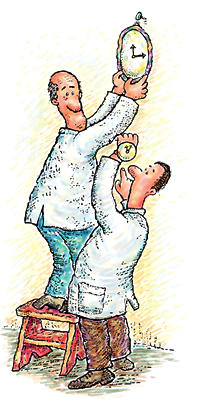
Clocks tick a little faster if you're a foot higher, NIST experiments have shown, confirming predictions from Einstein's general theory of relativity.
Scientists have long known that time passes faster at higher elevations—a curious aspect of Einstein's theories of relativity that previously has been measured by comparing clocks on the Earth's surface and a high-flying rocket. Now, physicists at the National Institute of Standards and Technology (NIST) have measured this effect at a more down-to-earth scale of 33 centimeters, or about 1 foot, demonstrating, for instance, that you age faster when you stand a couple of steps higher on a staircase.
Described in the Sept. 24 issue of Science, the difference is much too small for humans to perceive directly—adding up to approximately 90 billionths of a second over a 79-year lifetime—but may provide practical applications in geophysics and other fields. The NIST researchers also observed another aspect of relativity—that time passes more slowly when you move faster—at speeds comparable to a car travelling about 20 miles per hour, a more comprehensible scale than previous measurements made using jet aircraft.
NIST scientists performed the new "time dilation" experiments by comparing operations of a pair of the world's best experimental atomic clocks. The nearly identical clocks are each based on the "ticking" of a single aluminum ion as it vibrates between two energy levels over a million billion times per second. One clock keeps time to within 1 second in about 3.7 billion years (see "NIST's Second 'Quantum Logic Clock' Based on Aluminum Ion is Now World's Most Precise Clock") and the other is close behind in performance. The clocks are precise and stable enough to reveal slight differences that could not be seen until now.
The NIST experiments test two predictions of Einstein's theories of relativity. First, when two clocks are subjected to unequal gravitational forces due to their different elevations above the surface of the Earth, the higher clock—experiencing a smaller gravitational force—runs faster. Second, when an observer is moving, a stationary clock's tick appears to last longer, so the clock appears to run slow. Scientists refer to this as the "twin paradox," in which a twin sibling who travels on a fast-moving rocket ship would return home younger than the other twin.
In one set of experiments, scientists raised one of the clocks by jacking up the laser table to a height one-third of a meter (about a foot) above the second clock. Sure enough, the higher clock ran at a slightly faster rate than the lower clock, exactly as predicted.
The second set of experiments examined the effects of altering the physical motion of the ion in one clock. The ions are almost completely motionless during normal clock operations. NIST scientists tweaked the one ion so that it gyrated back and forth at speeds equivalent to several meters per second. That clock ticked at a slightly slower rate than the second clock, as predicted by relativity.
Such comparisons of super-precise clocks eventually may be useful in geodesy, the science of measuring the Earth and its gravitational field, with applications in geophysics and hydrology, and possibly in space-based tests of fundamental physics theories, suggests physicist Till Rosenband, leader of NIST's aluminum ion clock team.
The research was supported in part by the Office of Naval Research. For more details, see "NIST Pair of Aluminum Atomic Clocks Reveal Einstein's Relativity at a Personal Scale."
C.W. Chou, D.B. Hume, T. Rosenband and D.J. Wineland. Optical clocks and relativity. Science. Sept. 24, 2010.

